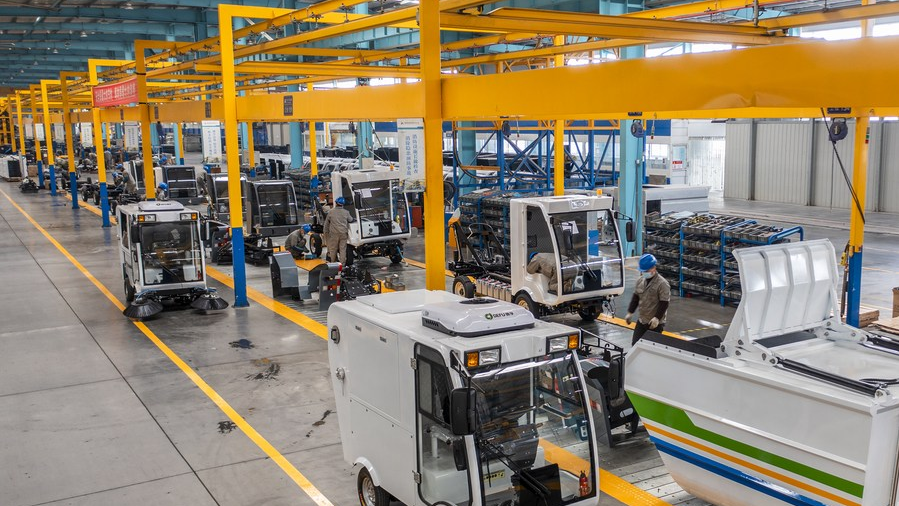
Workers are busy at a workshop producing new energy electric sweepers in Fanchang Economic Development Zone in Wuhu, east China's Anhui Province, January 12, 2023. /Xinhua
Workers are busy at a workshop producing new energy electric sweepers in Fanchang Economic Development Zone in Wuhu, east China's Anhui Province, January 12, 2023. /Xinhua
Editor's note: Liu Chunsheng is an associate professor at the Beijing-based Central University of Finance and Economics. The article reflects the author's opinion, and not necessarily the views of CGTN.
China's National Bureau of Statistics released economic data of the first two months in 2023. Despite the challenges, China's economy is picking up steam.
Retail sales, as the key indicator of consumption rose by 3.5 percent year-on-year in January and February. While in December 2022, it declined 1.8 percent. Consumption has become the main driver for China's economic growth, which is crucial when China, as the world's second largest economy and the hub of the manufacturing industry and international trade, is facing great uncertainty and risks in a chaotic world.
Both in the latest Central Economic Work Conference and Two Sessions, China stressed the significance of unleashing domestic demand and priority will be given to the expansion of consumption.
China has the world's largest population, with over 1.4 billion people. As more Chinese enter the middle class, they have more disposable income to spend on consumer goods and services. According to calculations from the Center for Strategic and International Studies, more than half of China's population – 707 million people – had joined the country's middle-income bracket by 2018, which represents a significant market for both domestic and international companies.
China's urbanization rate is increasing, with more people moving from rural areas to cities. The trend is expected to continue, as China's government has implemented policies to support urbanization and develop its cities. As urbanization continues, there will be more demand for consumer goods and services, such as housing, transportation and entertainment.
Another factor driving China's consumption potential is the rise of e-commerce. China has the world's largest online retail market, with companies including Alibaba and JD.com leading the way. E-commerce has made it easier for Chinese consumers to access a wider range of products and services, which has boosted consumption.
China has introduced a detailed plan to boost domestic consumption, as the country seeks to rebalance its economy away from an over-reliance on exports and investment. The government has implemented a range of measures to encourage spending, including reducing taxes, increasing social welfare programs and promoting e-commerce. Subsidy coupons are distributed to consumers in different regions. Accordingly, consumption will play a key role in China's economic growth in 2023 and later years.

Tourists enjoy performance at the Qilou Ancient Street during the Spring Festival holiday in Haikou, south China's Hainan Province, January 27, 2023. /Xinhua
Tourists enjoy performance at the Qilou Ancient Street during the Spring Festival holiday in Haikou, south China's Hainan Province, January 27, 2023. /Xinhua
The Chinese government is leading the efforts when confronting insufficient demand either from inside or outside. Fiscal stimulus has been a key part of China's economic recovery strategy. The government has implemented a range of tax breaks and subsidies to support businesses and encourage investment. Besides, The People's Bank of China (PBOC), the country's central bank, has lowered interest rates and provided liquidity support to the financial system to encourage lending and support economic activity.
One of the key components of this plan is to provide low-interest loans to small and micro enterprises. These loans will be provided through government-backed lending programs, which will make it easier for these companies to access the financing they need to expand. Additionally, the government will encourage financial institutions to provide more support to these companies by offering tax incentives and other benefits.
Moreover, the government has increased investment in infrastructure projects, such as transportation and energy, to create jobs and support economic growth. Infrastructure investment plan included projects such as 5G networks, data centers and green energy. This investment in infrastructure not only creates jobs in the short term, but has the potential to boost productivity and high-quality development in the long term.
China is looking to move up the value chain and build modern industries that can sustain long-term growth. One of the main drivers of China's push towards modern industries is the need to reduce its reliance on low-cost manufacturing and move towards higher-value-added production.
Advanced manufacturing is one of the key sectors targeted by China for development. This includes industries such as robotics, aerospace and new energy vehicles, which are seen as high-growth areas with significant potential for innovation and job creation. Beijing has launched a number of initiatives to support advanced manufacturing, which would upgrade the country's manufacturing capabilities through investment in research and development, automation and innovation.
In recent years, China has placed greater importance on the role of the private sector in driving economic development, which has led to significant growth in the sector, with private businesses now accounting for a larger share of the country's GDP and employment. Nonetheless, there is still room for improvement, particularly in terms of cutting regulatory burdens and upgrading access to financing.
(If you want to contribute and have specific expertise, please contact us at opinions@cgtn.com. Follow @thouse_opinions on Twitter to discover the latest commentaries in the CGTN Opinion Section.)